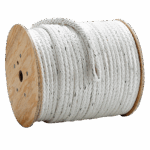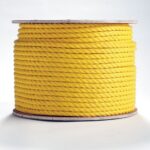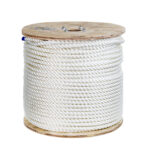Understanding the Difference Between Breaking Strength and Working Load Limits (WLL)
Choosing the right rope is about more than picking a diameter and material. To use rope safely and effectively, you need to understand two core ratings you will see most commonly on spec sheets and product pages: Breaking Strength and Working Load Limit (WLL).
Below, we explain the difference, how WLL is derived, what changes it in the field, and how to apply it with confidence.
Key Definitions
Breaking Strength: The Laboratory Benchmark
Breaking strength, also known as tensile strength, is the measured force at which a new rope fails under controlled testing. It represents the upper limit of performance in ideal conditions (i.e., straight pulls, no knots, no bends, and a pristine sample)
It’s important to remember: this number is not a safe guideline for everyday use.
In the field, ropes encounter bends, knots, shock loads, and environmental wear, all of which reduce their effective strength.
Working Load Limit (WLL): The Real World Standard
The Working Load Limit is the maximum safe load a rope should carry in actual use. It’s calculated by dividing the breaking strength by a safety factor. The safety factor accounts for the unknowns, such as wear, bending, knots, and the high stakes of a failure.
- General utility applications: Often use a 5:1 safety factor (about 20% of breaking strength)
- High-risk or life-safety applications: may require a 10:1 or greater ratio.
- Industrial and critical rigging: Factors can be higher depending on regulations or company policy.
The bottom line: WLL is a deliberately conservative number to protect both people and equipment.
Why Knots, Bends, and Conditions Matter
Even with a correctly calculated WLL, several factors can reduce rope performance in practice:
- Knots vs. splices: Knots can cut rope strength by up to 40% or more. Whenever possible, use splices or properly sized hardware.
- Bend radius: Running rope over a pin, sheave, or thimble that’s too small increases internal stress on the fibers. Larger bend diameters preserve both strength and service life.
- Shock loading: A sudden drop or stop can briefly generate forces several times greater than the static load. Ropes should never be exposed to shock loads above their WLL.
- Wear and environment: UV exposure, abrasion, chemicals, and heat all degrade fibers over time. Regular inspection and retirement are non-negotiable for safe use.
A Practical Example
Say you’re working with a polyester double braid rope rated at 7,400 lbs breaking strength.
- With a 5:1 safety factor, the WLL is about 1,480 lbs.
- If used in a human suspension or life-safety application, a 10:1 factor would reduce that safe working load to 740 lbs.
The rope hasn’t changed, but the acceptable use case has. That’s why matching WLL to the application is essential.
How to Select Rope Safely
- Identify the application and level of risk. A dock line, a crane line, and a lifeline all demand different safety factors.
- Start with breaking strength, then calculate WLL. Never assume you can work close to the rope’s ultimate strength.
- Use proper terminations. Splices, thimbles, and correct hardware maintain rope integrity far better than knots alone.
- Inspect before every use. Replace rope showing signs of abrasion, glazing, or core damage.
- Respect the environment. Heat, moisture, chemicals, and sharp edges all change performance.
Final Takeaways
Breaking strength tells you what the rope can withstand in a lab. Working Load Limit tells you what it can safely handle every day. The gap between those numbers — the safety factor — is what keeps your team, equipment, and operations secure.
At Erin Rope, these principles are our top priority, so you can trust that every product is backed by expertise, precision, and a commitment to safety. If you are unsure which rope and safety factor fit your job, contact our team today.




